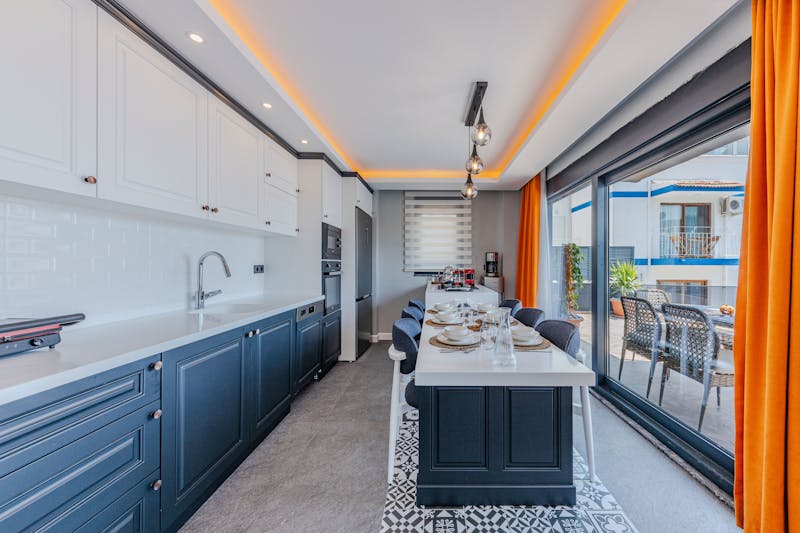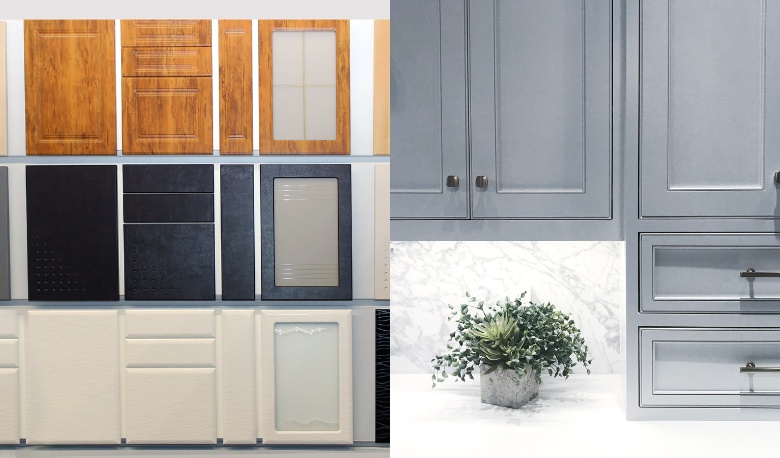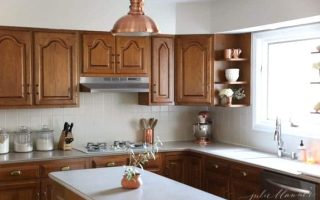Thermofoil cabinets, popular for their affordability and sleek, smooth finish, are made from medium-density fiberboard (MDF) with a vinyl coating. They’ve long been a go-to for budget-conscious homeowners. But what happens when you’re ready for a change? The good news is that painting thermofoil cabinets is possible, but it’s not as simple as painting wood. Here’s everything you need to know about this transformation, from preparation to achieving a long-lasting, professional look.
Why is painting thermofoil cabinets challenging?

Painting thermofoil cabinets is challenging because they have a smooth, non-porous vinyl coating that makes it difficult for regular paints to adhere. This surface is designed for moisture resistance and durability, but it also prevents standard paint from bonding effectively, often leading to peeling and chipping. Successful painting of thermofoil cabinets requires specific preparation steps, such as light sanding and applying a bonding primer, to ensure proper adhesion and long-lasting results. Skipping these crucial steps can result in a poor finish and wasted effort.
What are the pros and cons of painting thermofoil cabinets?
Before diving into the project, it’s essential to weigh the pros and cons of painting thermofoil cabinets.
Pros:
- Cost-effective update: Painting thermofoil cabinets is much cheaper than replacing or refacing them, making it a budget-friendly way to refresh your kitchen.
- Customization: You can choose from unlimited color options, allowing you to personalize your cabinets and create a unique style.
- Durability (with proper prep): With the right preparation, including sanding, priming, and sealing, painted thermofoil cabinets can be durable and withstand daily use.
Cons:
- Complex process: Painting thermofoil requires more steps than painting wood, including specialized primers and meticulous prep work.
- Risk of peeling: If the paint doesn’t bond properly or if the surface isn’t prepped well, peeling can occur, especially in high-moisture areas.
- Time-consuming: The project involves multiple stages like cleaning, sanding, priming, and allowing for proper drying and curing, making it a longer process.
Essential Steps to Painting Thermofoil Cabinets
To ensure success, follow these essential steps for painting thermofoil cabinets:
1. Prepping the Cabinets for Painting
- Remove Hardware and Doors: Start by removing all hardware, including doors, hinges, knobs, and handles. This ensures a smooth, uninterrupted painting surface and protects your hardware from getting damaged.
- Thoroughly Clean the Cabinets: Grease and grime build up over time, especially in kitchens. Use trisodium phosphate (TSP) or a similar degreasing cleaner to eliminate any residue that might prevent proper adhesion of the primer and paint.
- Sand the Surface: Lightly sand the vinyl surface using fine-grit sandpaper (220 grit works well) to create a rougher texture that the primer can cling to. Be careful not to sand too aggressively, as you don’t want to tear the vinyl.
- Repair Any Damage: If there are areas where the thermofoil is bubbling or peeling, carefully remove these sections and patch them with a wood filler to create a smooth, even surface.
2. Apply the Right Primer
The right primer is crucial for ensuring that the paint adheres properly to thermofoil cabinets. Opt for a bonding primer designed for non-porous surfaces, such as an oil-based or shellac-based primer.
- Apply Thin Coats: Avoid applying thick layers of primer, as this can lead to drips and uneven surfaces. Multiple thin coats are better for achieving a smooth, professional finish.
Product Recommendations
For primers, Zinsser B-I-N Shellac-Based Primer is a well-known option for its superior adhesion to non-porous surfaces. KILZ Adhesion Primer is another excellent choice for thermofoil cabinets, as it works well on slick surfaces.
When it comes to paint, consider Benjamin Moore Advance Interior Satin Paint, which is specifically designed for cabinetry, or Valspar Cabinet & Furniture Oil-Enriched Enamel, known for its durable finish. Both offer excellent coverage and longevity when used on thermofoil cabinets.
3. Choose the Right Paint
Not all paints are suitable for thermofoil cabinets. The best options include:
- Cabinet-specific paints designed for kitchen and bathroom cabinetry, which offer durability and moisture resistance.
- Acrylic latex paint with added bonding agents for enhanced adhesion.
- Specialized thermofoil paint, available from select manufacturers, designed to bond effectively to vinyl surfaces.
4. Protect the Finish with a Sealant
A protective topcoat is essential to prevent scratches and damage from moisture. Polyurethane or polycrylic sealers are good options to add durability to your cabinets and keep them looking fresh for years to come.
5. Allow Ample Drying and Curing Time
While it’s tempting to rush through the drying process, patience is key. Even though some paints may be labeled as fast-drying, they still require adequate curing time before cabinets can handle everyday use. Follow the manufacturer’s recommendations to ensure the paint hardens completely.
Tips for Achieving a Professional Finish

To achieve a flawless, professional finish on thermofoil cabinets, follow these expert tips:
- Practice first: Test your primer and paint on a scrap piece of thermofoil to perfect your technique and avoid common mistakes like brushstrokes or roller marks.
- Ensure proper ventilation: Work in a well-ventilated space to prevent fumes from affecting the paint’s drying process, helping it cure evenly and reducing issues like bubbling.
- Apply thin, even coats: Apply multiple thin coats of paint, allowing each to dry fully. Lightly sand between coats with fine-grit sandpaper for a smooth, factory-like finish.
Troubleshooting Common Problems
Even with careful preparation, issues can arise. Here are some troubleshooting tips for common problems:
- Peeling Paint: If the paint starts peeling, it’s usually due to inadequate surface prep or the wrong choice of primer. To fix this, gently sand down the peeling areas, apply a bonding primer, and repaint.
- Uneven Finish: Uneven application of paint can lead to patchy finishes. This is often caused by applying too thick a coat of paint or not allowing each layer to dry fully. Sand lightly with fine-grit sandpaper and apply thin, even layers of paint, ensuring proper drying between coats.
- Bubbles or Blisters: Paint bubbling is a result of trapped moisture or poor adhesion. Ensure the cabinets are thoroughly dry before applying any paint. If bubbles appear, sand them down after drying, and reapply a primer followed by the paint.
- Streaks or Brush Marks: Streaks occur when the paint is too thick or the wrong type of brush is used. Sand lightly between coats and use high-quality brushes or rollers to avoid visible strokes. Opt for a sprayer for the smoothest finish.
When to Consider Replacing Instead of Painting

While painting can be a cost-effective way to refresh your kitchen, there are times when it may not be the best solution. If your cabinets are severely damaged, peeling extensively, or the MDF underneath has deteriorated, painting won’t fix the problem. In these cases, replacing or refacing the cabinets may be a better investment in the long term.
Alternatives to Painting
- Refacing Cabinets: This involves replacing cabinet doors and drawer fronts but keeping the cabinet boxes intact. It’s less expensive than a full cabinet replacement but can still provide a dramatic transformation.
- Vinyl Wraps: Professionally applied vinyl wraps offer a durable alternative to painting, providing a wider range of colors and finishes.
FAQs
Is it worth it to paint thermofoil cabinets?
Yes, if your cabinets are structurally sound, painting is an affordable way to refresh your kitchen.
How long will painted thermofoil cabinets last?
With proper preparation and high-quality products, painted cabinets can last several years. However, their longevity will depend on factors like exposure to moisture and how well they’re maintained.
Should I hire a professional to paint thermofoil cabinets?
If you’re confident in your DIY skills, painting thermofoil cabinets is achievable. However, if you’re uncertain or have a large project, hiring a professional ensures a smoother finish and saves time.
Conclusion
Painting thermofoil cabinets is a rewarding project that can breathe new life into your kitchen. While the process requires careful preparation and specialized products, the cost savings and customizability make it a worthwhile investment. Whether you decide to tackle the project yourself or hire a professional, following these steps will help you achieve a beautiful, durable finish that transforms your space.




